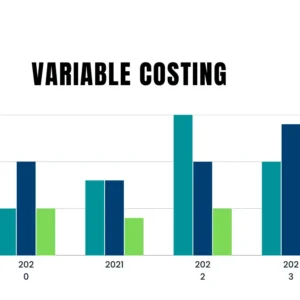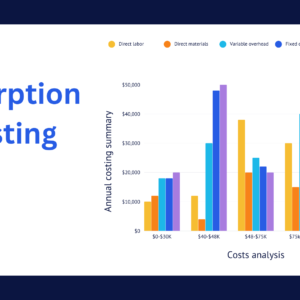What is process costing?
Process costing is a method used by businesses to calculate the total production costs for a specific process or department within a company. It involves allocating costs to individual units of output based on the average cost incurred during the production process. Process costing is one of the important concepts in manufacturing accounting.
This approach is commonly used in industries where large quantities of identical or similar products are produced in a continuous flow. Process costing enables companies to determine the cost per unit and evaluate the efficiency and profitability of their production processes.
Process vs job costing
| Aspect | Process Costing | Job Costing |
| Definition | Allocates costs to a specific process or department | Allocates costs to a specific job or project |
| Nature of Work | Mass production of identical or similar products | Customized or unique projects or products |
| Cost Allocation | Costs are averaged and allocated to each unit of output | Costs are directly traced to each job or project |
| Cost Accuracy | Provides an average cost per unit | Provides specific cost per job or project |
| Cost Monitoring | Monitors the costs and efficiency of the overall process | Monitors costs and efficiency of individual jobs |
| Examples | Oil refining, food processing | Construction, custom furniture manufacturing |
Importance
Cost Control:
It enables businesses to track and control costs at each stage of the production process. By identifying cost variances and analyzing cost drivers, companies can implement measures to reduce expenses, increase efficiency, and improve profitability.
Pricing Decisions:
Process costing provides accurate information about the average cost per unit produced. This information is crucial for setting appropriate prices for products or services, ensuring that the selling price covers the cost of production and generates a reasonable profit margin.
Performance Evaluation:
Process costing allows for the evaluation of the performance of individual processes or departments within an organization. By comparing actual costs with standard or budgeted costs, management can identify areas of improvement, allocate resources effectively, and optimize productivity.
Inventory Valuation:
Process costing provides a systematic approach to valuing inventory. It assigns costs to each unit of output based on the average cost incurred during the production process. This facilitates accurate financial reporting, including balance sheets and income statements, ensuring compliance with accounting standards.
Decision Making:
Accurate cost information from process costing is essential for informed decision-making. Whether it’s evaluating the feasibility of new projects, deciding on outsourcing opportunities, or determining whether to make process improvements, having reliable cost data helps in making sound and strategic business decisions.
Application
- Manufacturing: Industries involved in mass production, such as automobile manufacturing, electronics manufacturing, and food processing, use process costing to allocate costs and determine the cost per unit of their products.
- Chemical Processing: Companies engaged in the production of chemicals, pharmaceuticals, fertilizers, and other chemical products utilize process costing to track costs and monitor the efficiency of their production processes.
- Textile Industry: Textile manufacturers that produce fabrics, garments, and textiles on a large scale employ process costing to calculate the cost per unit and evaluate the profitability of their production lines.
- Oil Refining: The oil and gas industry utilizes process costing to allocate costs across different refining processes, such as distillation, cracking, and blending, to determine the cost per barrel of refined oil products.
- Construction: In construction projects, process costing is applied to track costs across various stages of construction, including excavation, foundation, framing, electrical, plumbing, and finishing. It helps contractors monitor project costs and estimate the cost of completed projects.
- Printing Industry: Printers and publishers use process costing to allocate costs in different printing processes, such as pre-press, printing, binding, and finishing, to calculate the cost per unit of printed materials.
- Food and Beverage Industry: Process costing is commonly employed in food and beverage manufacturing, where products go through different processing stages, such as milling, mixing, cooking, packaging, and labeling. It helps in determining the cost per unit of food and beverage items.
Steps in process costing
The process costing system involves several key steps to allocate costs and calculate the cost per unit. The typical steps in the process costing process are as follows:
- Identify the Process: Determine the specific process or department within the organization for which you want to calculate the costs. It could be a production line, a department in a factory, or a specific stage of the manufacturing process.
- Define the Cost Categories: Identify the different types of costs associated with the process. These costs can include direct materials, direct labor, and overhead costs. Direct materials are the materials that can be directly traced to the specific process, while direct labor refers to the labor directly involved in that process.
- Accumulate Costs: Accumulate the costs incurred during the production process for each cost category. This involves collecting data on direct materials used, direct labor hours or costs, and overhead costs.
- Calculate the Equivalent Units: Determine the equivalent units of production for each cost category. Equivalent units represent the number of fully completed units that could have been produced based on the work performed during the period. It takes into account partially completed units as well.
- Allocate Costs: Allocate the accumulated costs to the equivalent units. The costs are distributed based on the average cost per unit for each cost category. This involves dividing the total costs by the equivalent units to calculate the cost per equivalent unit.
- Calculate the Cost per Unit: Calculate the cost per unit by adding up the costs allocated to each cost category and dividing it by the total number of units produced during the period.
- Monitor and Analyze: Monitor the costs, analyze any variances from standard costs, and assess the efficiency and profitability of the process. This helps in identifying areas for improvement and cost control measures.
Types of process costing
Weighted Average Method:
In the weighted average method, the current period’s costs are combined with the previous period’s costs to determine the cost per equivalent unit. The total costs are divided by the total equivalent units to determine the average cost per unit.
First-In, First-Out (FIFO) Method:
The FIFO method assumes that the costs of units completed and transferred out are based on the costs of the earliest units in the production process. The costs incurred in the current period are assigned to the units completed and transferred out first.
Specific Identification Method:
The specific identification method tracks and assigns the actual costs of each unit in the production process. This method is typically used when each unit can be identified and tracked separately, such as in custom manufacturing or high-value goods.
Pors of process costing
- Cost Tracking: Process costing allows businesses to accurately track costs at each stage of production. This helps in identifying cost variations, inefficiencies, and areas for improvement. By monitoring costs, businesses can take proactive measures to control expenses and optimize resource allocation.
- Cost Estimation: Process costing provides a reliable basis for estimating the cost of production. By calculating the average cost per unit, businesses can make accurate cost projections for production planning, budgeting, and pricing decisions.
- Inventory Valuation: Process costing facilitates accurate inventory valuation. By allocating costs to each unit of output, businesses can determine the value of work-in-progress (WIP) inventory and finished goods. This helps in maintaining accurate financial records, preparing financial statements, and complying with accounting standards.
- Performance Evaluation: Process costing enables businesses to evaluate the performance of different processes or departments within the organization. By comparing actual costs with standard costs, management can identify variances and inefficiencies.
- Decision Making: Process costing provides valuable cost information for decision-making. Businesses can make informed choices regarding process improvements, product diversification, pricing strategies, and resource allocation based on accurate cost data.
- Compliance and Reporting: Process costing helps businesses comply with regulatory requirements and reporting standards. Accurate cost information facilitates the preparation of financial statements, tax filings, and cost reports required by regulatory bodies and stakeholders.
Practical example
ABC Manufacturing produces widgets using a continuous production process. In a given month, the company incurs the following costs in its production process:
- Direct materials cost: $50,000
- Direct labor cost: $30,000
- Overhead cost: $20,000
During the month, the production process yields 10,000 units of widgets. At the end of the month, there were 500 units in the ending WIP inventory.
To calculate the cost per unit using process costing, we need to follow these steps:
- Determine the equivalent units of production:
- Units completed and transferred out: 10,000 units
- Units in ending WIP inventory: 500 units
- Calculate the total equivalent units: Total equivalent units = Units completed and transferred out + Units in ending WIP inventory = 10,000 units + 500 units = 10,500 units
- Calculate the cost per equivalent unit: Total production costs = Direct materials cost + Direct labor cost + Overhead cost = $50,000 + $30,000 + $20,000 = $100,000
- Cost per equivalent unit = Total production costs / Total equivalent units = $100,000 / 10,500 units = $9.52 per unit
Therefore, in this example, the cost per unit using process costing is $9.52. This cost per unit can be used for various purposes such as inventory valuation, pricing decisions, and performance evaluation.
Cons of process costing
- Lack of Precision: Process costing relies on averaging costs across a large number of units produced. This can result in a lack of precision when allocating costs to individual units. In industries where products vary significantly in terms of complexity, size, or customization, process costing may not accurately reflect the specific costs associated with each unit.
- Difficulty in Tracking Costs: As the production process advances, it becomes challenging to track and assign costs to individual units or batches. This can make it difficult to identify the exact cost incurred for specific activities or processes. It may also limit the ability to trace costs back to specific sources or activities for cost control and decision-making purposes.
- Ignoring Unique Characteristics: Process costing does not consider the unique characteristics or customization of individual products. It treats all units as homogeneous, assuming they have similar production costs. This approach may not adequately account for the impact of design changes, customization requests, or variations in production requirements, which can result in inaccurate cost calculations.
- Inefficient Cost Allocation: Process costing allocates costs based on average rates per unit, which may not reflect the actual consumption of resources by each unit. This can lead to inefficiencies in cost allocation, as units that require fewer resources may be assigned higher costs, while units that require more resources may be assigned lower costs.
- Difficulty in Cost Control: Since process costing provides averaged costs, it may be challenging to identify specific cost variances or inefficiencies within the production process. This can hinder effective cost-control measures and the identification of improvement opportunities.
- Limited Decision-Making Insights: Process costing may not provide the detailed cost information necessary for certain types of decision-making, such as pricing decisions for customized products, evaluating the profitability of specific customer orders, or determining the cost-effectiveness of individual process improvements.
It’s important to note that the suitability of process costing depends on the nature of the industry, the level of product homogeneity, and the specific business requirements. In some cases, alternative costing methods, such as job costing or activity-based costing, may be more appropriate to address the limitations of process costing.





[…] Process costing is a costing method used by manufacturers to allocate costs to a continuous production process, where products are indistinguishable from one another. It is commonly employed in industries that involve mass production or continuous manufacturing, such as chemicals, food processing, and textiles. […]
[…] Process Costing is a costing method widely employed in industries with continuous production of similar goods. For instance, in a chemical manufacturing plant, the production of a standardized chemical product involves sequential processes like mixing, refining, and packaging. The total production costs, including raw materials, labor, and overhead, are evenly distributed across the total units produced during a specific period. This results in a per-unit cost for each stage of the process. […]